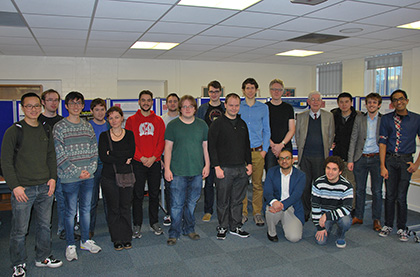SIAM Chapter Day
January 15th 2015, Cardiff University

Objectives
This one-day event is the third in an annual series which aims to provide a platform for discussions on current research on mathematical modelling, analysis, and simulation of problems in science and engineering.
Following the format of the very successful Cardiff SIAM Days in 2013 and 2014, doctoral students and postdoctoral researchers from across Cardiff University and their guests from other Universities are invited to showcase and communicate their recent results in the form of a poster accompanied by a title and a set of bullet points highlighting the core findings of their work.

The Cardiff University SIAM Student Chapter members and guest speakers at the 3rd Annual SIAM Chapter Day, Cardiff University, Wales, UK, January 15, 2015.
Confirmed Guest Speakers
Prof Des Higham (University of Strathclyde, Scotland)
Talk: Twitter Dynamics
Abstract: Digital records of human interactions produce large-scale and rapidly changing data sets. Information such as who phoned whom and who tweeted whom provides a fascinating insight into our behaviour that can be of great value to social scientists, commercial organisations and governments. I will discuss some recent mathematical models and resulting algorithms that deal with the evolution of these interactions and help us quantify the central players. I will show some results on Twitter data.
Prof Peter Wells (Cardiff University, Wales)
Talk: Towards better medical ultrasound.
Abstract: After X-rays, ultrasound is the most commonly-used medical imaging technology. Following a brief explanation of current clinical ultrasonic imaging techniques and their limitations, some of the principal areas of contemporary research will be described, with an emphasis on the problems which might benefit from mathematical approaches.
See also: http://www.bbc.co.uk/news/uk-wales-south-east-wales-29191849
Prof Kevin Glazebrook (University of Lancaster, England)
Talk: A graph patrol problem with random attack times.
Abstract: A patroller traverses a graph to detect and then thwart potential attacks at nodes. In deciding how to patrol, the patroller needs to take account of many things: the structure of the graph, the possibly different attack time distributions at distinct nodes, the different costs which may be incurred depending on where an attack takes place. Simple, natural ways of patrolling (like repeatedly walking up and down a line graph) may perform poorly. Both random and strategic attackers are considered in the work. We use Lagrangian relaxation to develop index-based heuristics which are easy to compute and which typically achieve within 1% of (cost) optimality.
